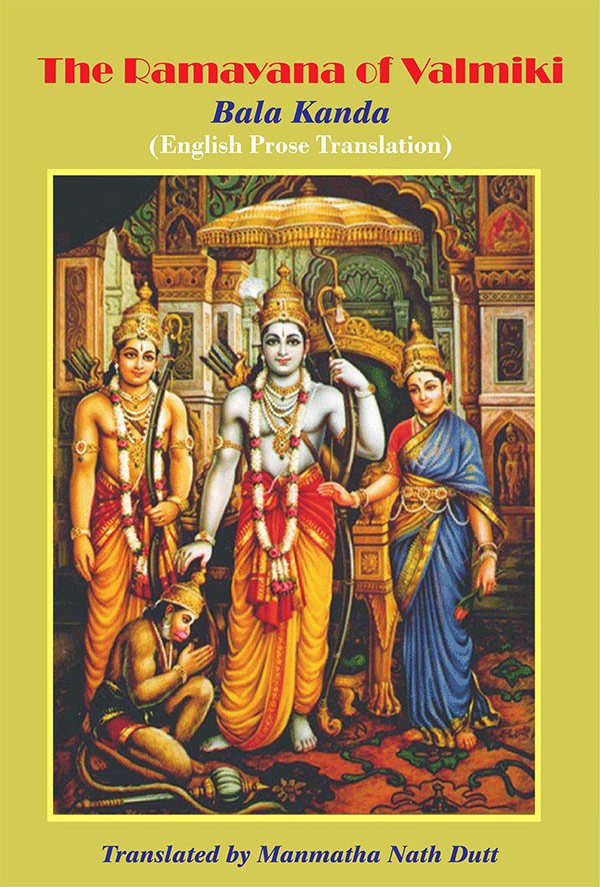Ramayana
by Manmatha Nath Dutt | 1891 | ISBN-13: 9788171101566
This page describes Chapter V of the English translation of the Ramayana, one of the largest Sanskrit epics of ancient India revolving around the characters Rama, Sita and Ravana. It was orignally authored by Valmiki at least over 2500 years ago. This is the first book of the Bāla-kāṇḍa (Bala-kanda) of the Ramayana, which consists of 24,000 Sanskrit metrical verses divided oer seven books.
Chapter V
This great story of Rāmāyaṇa treats of those victorious kings commencing with Prajāpati, and having Ikṣvāku for their founder, who ruled the entire earth as no other kings had done so before them, and in whose line Sagara was born—Sagara who dug the ocean, and whom, while out in progress, his sixty-thousand sons followed.
We shall now chant the entire history of that dynasty from the beginning. Do you, with minds free from ill will, listen to that story conferring merit, profit and pleasure.
There is on the banks of the Sarayū a great and flourishing country called Kośala abounding in com and wealth, in which the inhabitants passed their days pleasantly.
The capital of that country was Ayodhyā famed among men, which was founded by Manu himself that foremost of men.
That beautiful and mighty city was twelve Yojanas in length and Three in breadth; and was intersected outside with spacious roads laid out orderly.
And scattered with blown blossoms, and regularly sprinkled with water; the well-arranged broad high-ways looked beautiful.
That one bringing prosperity into great kingdoms, King Daśaratha, lived in that city, like that of the lord of the deities inhabiting the celestial regions.
And the city was furnished with doors and gates, and well-arranged rows of shops. And it contained all kinds of instruments and arms, and was inhabited by all classes of artizans.
And that graceful and matchlessly brilliant city abounded in eulogists and genealogists. And it was crowned with stately edifices with flags, and guarded by hundreds of Śatāghnīs. (A weapon commonly described as a stone set round with iron spiles).
And the mighty city contained theatres for females, and gardens, and mango-groves; and was enclosed by a wall of sāla trees.
And encircled by a deep moat, the city was not accessible for enemies. And it abounded with elephants and horses, and kine and camels and asses.
It was thronged with neighbouring kings come to pay tribute, and inhabited by merchants from various countries.
And adorned with mountain like palaces glittering with gems, and filled with sporting-places for females, and like to Indra’s Amarāvatī.
The city was wonderful to behold, gleaming with gold-bumished ornaments, and inhabited by troops of courtezans, and abounding in all kinds of gems, and graced with royal palaces.
And it abounded in paddy and rice, and its water was sweet as the juice of the sugar-cane.
And it resounded with the sounds of Dundubhis and Mṛdaṅgas and Vīṇās and Paṇavas.
And that foremost spot of all the earth was like an aerial car obtained in heaven by the Siddhas, through force of ascetic austerities, and thronged with the best specimens of humanity.
That city was filled by king Daśaratha with thousands of such Mahārathas[1] light-handed and accomplished in fight, as could by force of arms or sharpened shafts slaughter infuriated lions and tigers and boars roaming in the forest; yet as would not pierce with arrows persons lorn or abandoned or hiding or fugitive.
A warrior fighting ten thousand Mahārathas.
It abounded mostly in excellent Brāhmaṇas, lighting the sacrificial fire, and crowned with qualities, and versed in the Vedas and the Vedāṅgas, and giving away thousands, and ever abiding by truth, and high-souled, and resembling might ascetics.
Footnotes and references:
[1]:
A warrior coping with ten thousand persons, and protecting both his charioteer and steeds.
